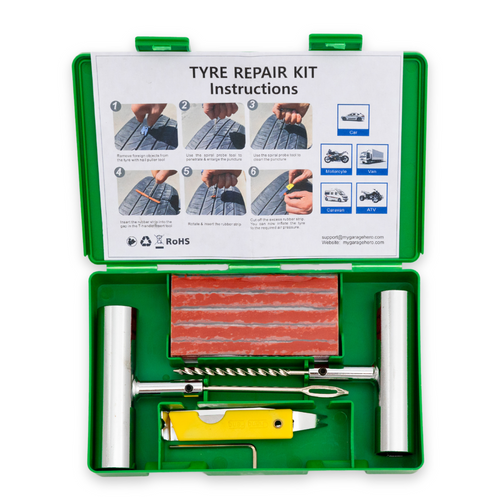Tyre pressure is a crucial aspect of vehicle maintenance that often goes unnoticed. Many drivers overlook its importance, yet it plays a vital role in safety and performance.
Proper tyre pressure ensures optimal contact with the road, enhancing grip and control. It also contributes to better fuel efficiency, saving you money in the long run.
Under-inflated or over-inflated tyres can lead to uneven wear and potential blowouts. This can compromise your safety and increase the risk of accidents.
Regularly checking and maintaining the correct tyre pressure is a simple task. It can prevent costly repairs and ensure a smooth driving experience.
What is Tyre Pressure and Why Does it Matter?
Tyre pressure refers to the amount of air inside the tyre, measured in PSI (pounds per square inch). It determines how well the tyre maintains contact with the road.
Proper tyre pressure is critical for several reasons:
-
Safety: Ensures optimal traction and handling.
-
Efficiency: Improves fuel economy by reducing rolling resistance.
-
Durability: Extends tyre life by promoting even tread wear.
Under-inflated tyres can lead to excessive wear and increased fuel consumption. This happens because more surface area contacts the road, causing friction. Over-inflated tyres decrease the contact patch, leading to reduced grip and harsher ride quality.
Inaccurate tyre pressure affects braking, cornering, and overall stability. It compromises safety by increasing the risk of blowouts and loss of vehicle control. Maintaining the correct pressure helps avoid these issues, providing a safer driving experience.
Understanding and managing tyre pressure is fundamental for both novice and experienced drivers. It ensures the longevity and peak performance of your tyres, ultimately enhancing road safety.
Recommended Tyre Pressure: How Much Air Should Be in Your Tyres?
Knowing the recommended tyre pressure for your vehicle is crucial. It ensures optimal performance and safety during every drive. The correct pressure varies by vehicle and tyre type.
You can usually find the recommended tyre pressure:
-
On a sticker inside the driver’s door.
-
In the vehicle’s owner manual.
-
Sometimes on the fuel cap.
Typically, car tyre pressure ranges between 30-35 PSI. However, it's essential to refer to your specific vehicle’s recommendations, as SUVs, trucks, and sports cars may differ.
The pressure should be adjusted according to load and driving conditions. Consider additional PSI for heavy loads or long-distance travel to maintain stability. Remember, a precise balance of pressure is key to smooth driving and efficient fuel use.
Regularly checking and maintaining the correct tyre pressure helps avoid uneven wear. Proper pressure also mitigates the risk of tyres blowing out unexpectedly. Thus, ensuring the recommended pressure is maintained will prolong tyre life and enhance safety.
How to Check Tyre Pressure: Step-by-Step Guide
Checking tyre pressure is a simple but vital task. It keeps your vehicle safe and efficient. Here's a guide to help you check pressure accurately.
First, ensure your tyres are cold. This means your vehicle hasn't been driven for about three hours. Cold tyres give a more accurate pressure reading.
Gather the necessary tools. You'll need a reliable tyre pressure gauge. These are available in digital or analog forms and are easy to use.
Follow these steps to check your tyre pressure:
-
Remove the valve cap from the tyre.
-
Firmly press the pressure gauge onto the valve stem.
-
Read the pressure displayed on the gauge.
-
Compare the reading to your vehicle's recommended PSI.
-
Adjust the pressure if necessary, adding or releasing air.
Remember to check all four tyres. Don't forget the spare tyre, as it's often overlooked. Regularly checking your tyre pressure can prevent common tyre issues.
Consistency is key. Make it a habit to check the pressure at least once a month. Frequent checks ensure tyres are always at their best performance level.
Tyre Pressure Charts and PSI Conversion
Tyre pressure varies with vehicle type and tyre size. Charts are helpful tools for determining the ideal pressure. These charts provide PSI recommendations tailored to specific tyre dimensions and models.
When using a tyre pressure chart, locate your tyre's size on the list. The size is usually marked on the tyre's sidewall. Once identified, match it to the recommended PSI value from the chart. This ensures you're inflating your tyres correctly.
Additionally, understanding PSI conversion is vital. Different regions may use different units to measure pressure. Below are common conversions to consider:
-
1 PSI = 0.0689 bar
-
1 PSI = 6.895 kPa
Accurate PSI is key to vehicle safety and performance. Be sure to double-check the values if you're traveling abroad or using an international chart. Proper tyre pressure enhances fuel efficiency and extends tyre lifespan, making attention to PSI crucial for all drivers.
Factors That Affect Tyre Pressure
Several factors can influence tyre pressure. One primary factor is temperature changes. Cold weather causes air to contract, reducing tyre pressure, while heat causes expansion.
Driving conditions also play a part. Long trips can raise tyre temperatures due to friction. This heat causes tyre pressure to increase temporarily, affecting handling.
Vehicle load is another consideration. Carrying heavy loads puts extra pressure on tyres, often requiring adjustments in air pressure. Maintaining optimal pressure ensures safety and performance under these conditions.
Different road surfaces and altitudes impact pressure, too. Rough terrain or high altitudes can lead to pressure loss. It's essential to monitor and adjust tyre pressure accordingly. Regular checks and understanding these factors help maintain the best pressure for your tyres. Here's a summary of the key factors:
-
Temperature changes
-
Driving conditions
-
Vehicle load
-
Road surfaces and altitude
Being aware of these elements can prevent under-inflation or over-inflation, promoting a safer driving experience.
The Impact of Incorrect Tyre Pressure
Driving with incorrect tyre pressure can have severe consequences. Under-inflated tyres increase rolling resistance, which can lead to greater fuel consumption and higher costs over time.
Moreover, tyres lacking adequate pressure wear out unevenly. This increased wear can lead to quicker tyre degradation, resulting in the need for more frequent replacements, an avoidable expense.
Over-inflated tyres present another set of risks. They can reduce the contact patch between the tyre and the road, diminishing traction and affecting braking distance. This reduced contact can also lead to a harsher, less comfortable ride.
Incorrect tyre pressure also impacts vehicle handling, particularly during cornering and in wet conditions. The vehicle may not respond as expected, increasing the risk of accidents. A short list of impacts includes:
-
Increased fuel consumption
-
Uneven tyre wear
-
Reduced traction and handling
-
Higher risk of accidents
Regularly checking and maintaining the correct tyre pressure can help avoid these issues and ensure a safer driving experience.
How to Adjust Tyre Pressure: Tools and Tips
Adjusting tyre pressure is a straightforward task that requires minimal tools. An accurate tyre pressure gauge is essential, as it ensures you get precise readings. Additionally, an air compressor or a visit to a service station can help inflate your tyres to the correct pressure.
Before adjusting, always check the tyre pressure when the tyres are cold, as driving heats them and can give inaccurate readings. It's a good idea to reference your vehicle’s owner manual or the sticker inside the driver's door to find the recommended tyre pressure.
Here are key steps to adjust tyre pressure:
-
Use a gauge to check current pressure.
-
Add or release air, as needed.
-
Recheck to ensure accuracy.
-
Repeat for all tyres, including the spare.
Always make it a habit to keep your tyre pressure within the recommended range to maintain optimal vehicle safety and performance. Regular maintenance checks will help catch any discrepancies early.
Tyre Pressure for Different Vehicles and Conditions
Tyre pressure requirements vary greatly between different types of vehicles. Each vehicle type, from sedans to SUVs, and trucks have distinct tyre pressure needs. It's important to understand these differences to ensure safety and performance.
Driving conditions also influence tyre pressure requirements. Carrying heavy loads or towing can change the optimal tyre pressure for your vehicle. It's crucial to adapt to these conditions to maintain tyre integrity and vehicle control.
Consider these factors for adjusting tyre pressure:
-
Vehicle type and size.
-
Load weight being carried.
-
Weather conditions and altitude.
By considering these elements, you can make the necessary tyre pressure adjustments. This proactive approach guarantees that your tyres are ready for varied situations, enhancing safety and improving driving comfort. Always consult your vehicle's manual to find precise recommendations for any specific adjustments needed.
Frequently Asked Questions About Tyre Pressure
Understanding tyre pressure can be daunting for some drivers. Many have common questions about how to maintain proper air levels. Clarifying these can help ensure a safer and more efficient driving experience.
Here are some frequently asked questions about tyre pressure:
-
How often should I check my tyre pressure?
-
What tools do I need to measure tyre pressure?
-
How does temperature affect tyre pressure?
Answers to these questions can help address common concerns. Regular checks, using a reliable tyre pressure gauge, are recommended. Understanding how temperature variations affect pressure ensures better vehicle performance. When in doubt, refer to your vehicle's owner manual or contact a professional for guidance.
Key Takeaways and Tyre Pressure Maintenance Checklist
Maintaining proper tyre pressure is crucial for safety and efficiency. Regular checks can prevent issues like blowouts and uneven wear. Knowing the correct PSI for your vehicle and tyres ensures better performance and fuel economy.
Here's a quick tyre pressure maintenance checklist to keep in mind:
-
Check tyre pressure monthly and before long trips.
-
Use a reliable tyre pressure gauge.
-
Adjust tyre pressure for load and weather conditions.
-
Refer to your vehicle's manual for recommended PSI.
-
Inspect tyres for visible damage regularly.
By following these tips, you can prolong the lifespan of your tyres and enjoy a smoother ride. Regular maintenance not only enhances safety but also improves driving comfort and efficiency.




